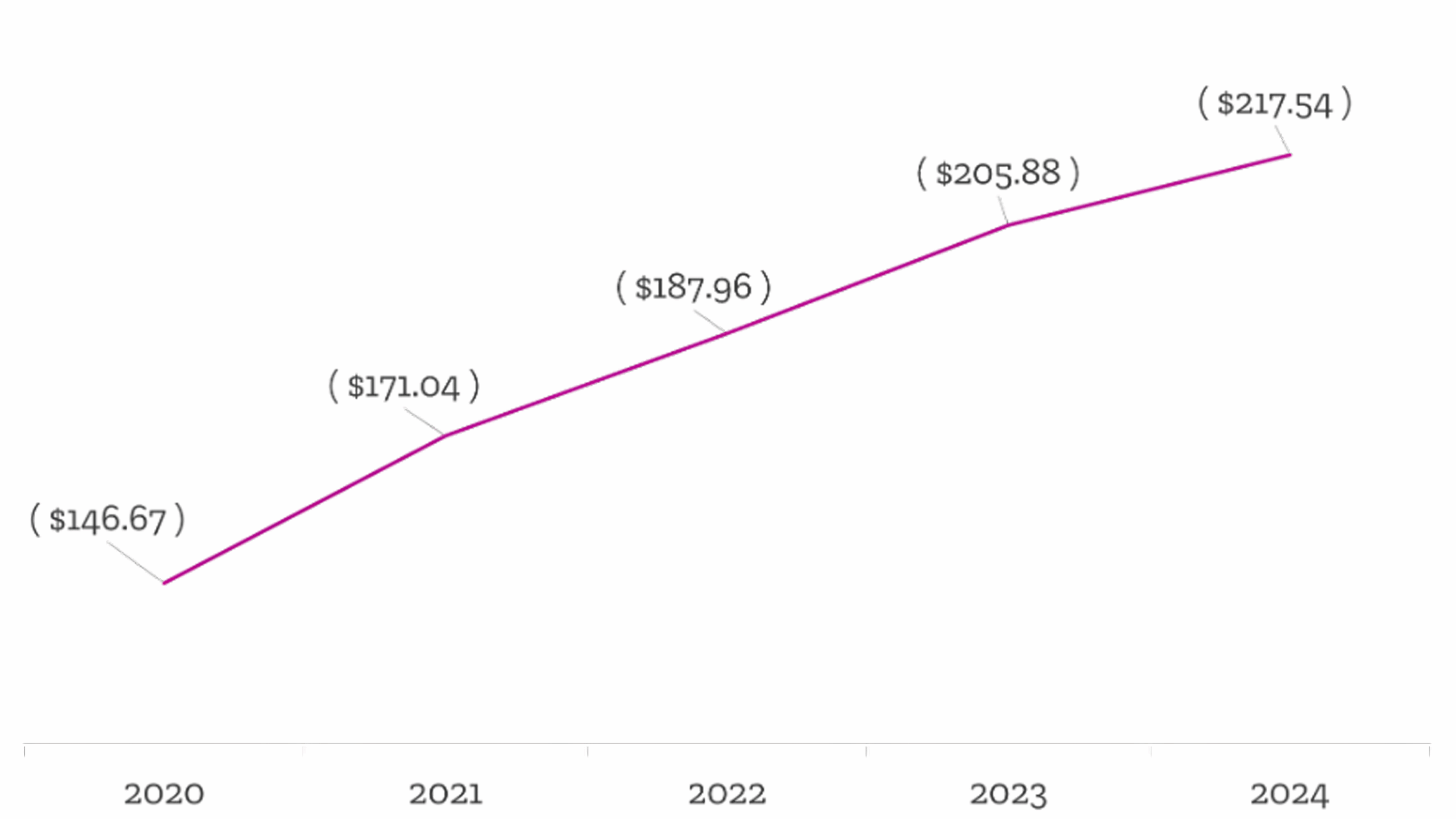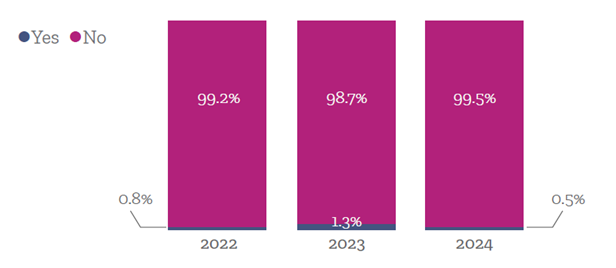Our industry is engaged in an important dialogue to improve the efficiency and resilience of real assets through transparency and industry collaboration. This guest article contributes to that conversation and does not necessarily reflect GRESB’s views or position, nor does it represent an endorsement. The GRESB Insights blog is designed to share diverse industry perspectives and foster informed discussion on key topics for real assets investments.
New data from the IREM® Income/Expense IQ financial benchmarking program reveals a sharp rise in utility costs across U.S. multifamily properties, with implications for sustainability, operational efficiency, and ESG performance. Between 2023 and 2024, total per-unit utility expenses for multifamily assets rose 13.4%, from USD1,102 to USD1,250. Electricity costs increased 5.7%, and heating fuel rose 4.3%. Income/Expense IQ data shows that per-unit electricity costs for multifamily properties have increased by 48.3% since 2020.
Per-unit electricity costs in multifamily properties IREM Income/Expense IQ, 2020-2024

Source: IREM Income/Expense IQ, irem.org/tools/income-expense-iq
US office properties showed more stability, with total utility costs increasing only slightly from USD1.89 to USD1.90 per square foot. Electricity costs for office buildings declined from USD1.56 to USD1.47. US industrial properties saw a dramatic surge in utility costs, more than doubling from USD0.18 to USD0.40 per square foot, but communications expenses are the source of the overall increase. For industrial properties, electricity costs dipped slightly, and natural gas costs dropped significantly.
Data from the US Energy Information Administration (EIA) shows that retail electricity prices have increased faster than the rate of inflation since 2022 and are expected to continue increasing through 2026.[1]
AI offers greater reductions
These trends underscore the urgency for GRESB Real Estate Assessment participants to continue to prioritize energy efficiency—and pursue greater reductions—across asset types. AI-powered solutions offer promising opportunities to reduce utility costs through smart energy management, predictive maintenance, and real-time monitoring. Technologies that optimize HVAC systems, detect issues, and forecast usage can drive down expenses through efficiency.
However, adoption of AI for energy management remains surprisingly low. According to a 2025 IREM and AppFolio survey of almost 2,000 real estate management professionals, with results published in the report AI on the Rise: Adoption in Property Management Gains Traction[2], adoption of AI tools is accelerating, but it’s primarily being applied to leasing, communication, and document analysis. Survey results show that only 0.2% of AI users apply it to energy management and 2.5% to preventive maintenance. This gap suggests that many properties are missing out on the full potential of AI to enhance operational efficiency and sustainability.
AI-powered energy management systems, when integrated with building management systems (BMS), offer a powerful solution for optimizing energy use. These systems combine real-time data analytics, machine learning, and automation to monitor and control energy consumption across HVAC, lighting, water, and other building systems.
Key features typically include:
- Smart monitoring: Continuous tracking of energy and water usage across zones and equipment, often visualized through dashboards connected to the BMS.
- Predictive maintenance: AI identifies patterns that signal equipment wear or inefficiency, allowing for proactive servicing before failures occur.
- Automated controls: AI dynamically adjusts HVAC, lighting, and other systems based on occupancy, weather, and usage trends, improving comfort and reducing waste.
- Energy forecasting: Algorithms predict future energy demand, helping operators plan for peak loads and optimize energy procurement.
- Optimization algorithms: Algorithms balance energy use with cost and performance goals, often in real time.
- Renewable integration: AI can manage solar, battery storage, and other renewable systems to reduce grid reliance and maximize clean energy use.
AI-powered energy management systems integrated with BMS enable buildings to participate in voluntary demand response (DR) programs by automating and optimizing energy use in response to grid signals.
These systems monitor real-time energy consumption and external factors like weather, occupancy, and utility pricing. When a utility or grid operator issues a DR event—typically during peak demand periods—AI systems can automatically reduce energy usage by adjusting HVAC settings, dimming lights, or temporarily powering down non-essential equipment. This helps stabilize the grid and earns incentives for participating buildings.
Yet, there’s a caveat. AI systems, especially large-scale models, require significant computational power, which translates into high electricity consumption. This increased demand on the power grid often relies on fossil fuel-based energy sources, leading to higher carbon emissions. Improving data center efficiency and sourcing electricity from renewable energy can significantly reduce these environmental impacts. That’s why it’s critical to pair AI adoption with renewable energy sources, battery storage, and grid-friendly technologies.
GRESB participants should consider structured AI deployment strategies that align with sustainability goals. This includes investing in staff training, establishing governance policies, conducting pilot programs, and using clean energy along with AI solutions.
Digital twin technology
Digital twin is another emerging technology that holds great promise for energy management. A digital twin is a real-time, virtual replica of a physical asset, system, or process. These digital models continuously ingest data from sensors, BMS, and IoT devices to simulate, monitor, and optimize building performance.
Digital twin offers these benefits:
- Real-time monitoring and simulation: Digital twins provide a dynamic view of energy flows, equipment status, and environmental conditions. Operators can simulate different scenarios—like occupancy changes or weather impacts—to predict energy demand and adjust systems accordingly.
- Predictive maintenance: Digital twins analyze historical and real-time data to forecast equipment failures and inefficiencies, enabling timely interventions that reduce energy waste and extend asset life.
- Operational optimization: Digital twin systems help fine-tune HVAC, lighting, and water systems by modeling how changes affect energy use, comfort, and cost. AI algorithms within the twin can recommend or automate adjustments for peak efficiency.
- Integration with renewables: Digital twins can model the performance of solar panels, battery storage, and other renewable systems. This helps buildings maximize clean energy use and reduce grid dependence.
- Enhanced decision-making: Real estate managers and their teams gain actionable insights through visual dashboards and simulations, supporting strategic planning and ESG reporting.
Like AI for energy management, digital twin technology is underutilized. The 2025 IREM Proptech Insights survey and report, which assesses adoption of different building technologies, found that only 0.5% of respondents used digital twin in their buildings.
2025 IREM Proptech Insights
Has digital twin technology been implemented at your property?

Source: 2025 IREM Proptech Insights, irem.org/tools/technology
The most powerful strategy is a combination of approaches—energy efficiency projects to reduce consumption, renewable energy, digital twin, and AI-powered energy management solutions. With this approach, the solutions are an integrated system that allows owners and managers to monitor, predict, and optimize building performance in real time.
Energy efficiency measures reduce baseline consumption as renewables offset grid reliance. Digital twins simulate building operations and identify inefficiencies before they escalate, and AI automates responses to changing conditions and forecasts demand, while enabling participation in demand response programs. Together, these technologies create a dynamic, data-driven environment that supports cost savings, sustainability goals, and operational resilience.
In a landscape of rising expenses, utilities stand out as both a challenge and a catalyst for innovation. By embracing AI responsibly and strategically, real estate leaders can reduce costs, improve ESG performance, and future-proof their portfolios.
References
[1] U.S. Energy Information Administration. Short-Term Energy Outlook (May 2025). Available at: eia.gov/outlooks/steo/
[2] IREM & AppFolio. AI on the Rise: Adoption in Property Management Gains Traction (2025). PDF: irem.org/file%20library/globalnavigation/learning/tech%20hub/irem-ai-survey-25-fnl.pdf
This article was written by Todd Feist, Director, Sustainability Programs at IREM. Learn more about IREM here.